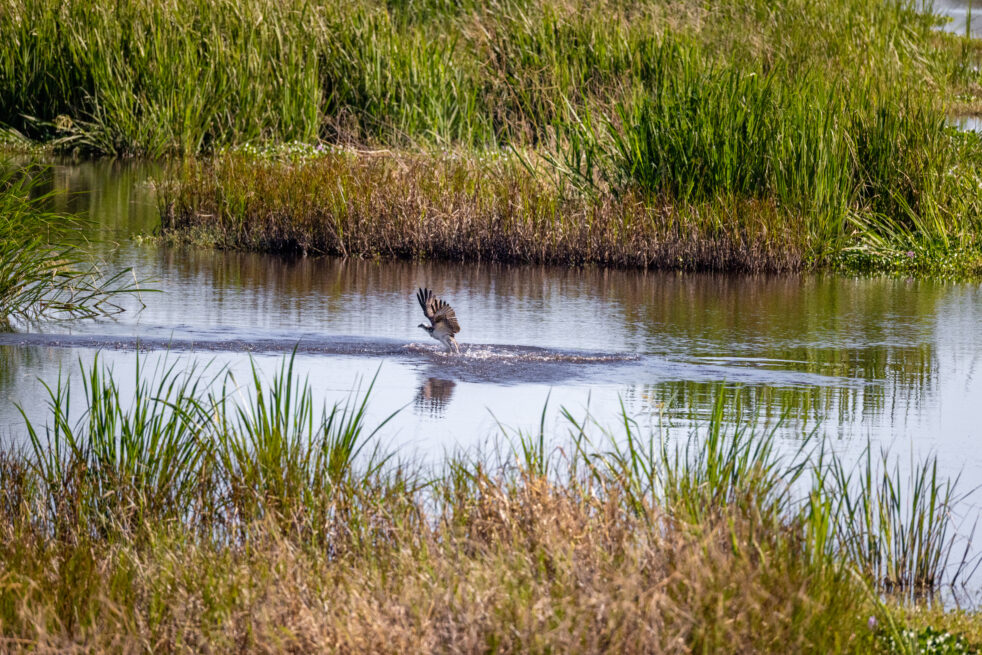The Okefenokee National Wildlife Refuge, encompassing more than 400,000 acres between the border of Georgia and Florida, is a crucial refuge for endangered and threatened flora and fauna. Its expansion is extraordinarily special to many, including Lily Mason, a fifth-year PUBP student.
“The connection goes back to being a kid and visiting the swamp with my dad and my brother,”said Mason.
“I got involved with the effort to protect the Okefenokee swamp from mining in the 2023 legislative session when I was working on a paper about HB 71, a bill introduced to prohibit mining on Trail Ridge.”
After several years of concerned citizens and conservation organizations making complaints to the agency, in Oct. 2024, the U.S. Fish and Wildlife Service (FWS) began considering a proposal for a nearly 22,000-acre expansion of the refuge. This expansion would include lands held by Twin Pines Minerals, LLC and areas within a 1-mile fuel reduction zone. To gather public input, an in-person meeting on Nov. 12, 2024, and a virtual counterpart on Dec. 9, 2024, were held by the Fish and Wildlife Service. The public submitted nearly 30,000 comments — from 36 countries and all 50 states — generally supportive of the proposal.
On Dec. 20, 2024, the Department of Interior nominated the Okefenokee National Wildlife Refuge to be considered for the UNESCO World Heritage List, reflecting the national sentiment.
On Jan. 3, 2024, the FWS approved the proposed expansion of the refuge, barring some minor mapping error corrections.
The expansion was met with widespread cheer, relief and gratitude from supporters near and far. Michael Lusk, the Okefenokee Refuge Manager, called the response “a testament to just how special Okefenokee is, not just to our local community, but to people all over the nation and around the world”.
This is not the first time a similar timeline of events took place. In 1996, a mining company DuPont put forth a proposal for strip-mining near the National Wildlife Refuge in Charlton County. After facing similar public outrage and a resultant border expansion of the Okefenokee, the company pulled its proposal and donated its land to the refuge in 2003.
Josh Marks, president of Georgians for the Okefenokee, fought the original proposal in 1996. He viewed the Jan. 3 Okefenokee expansion as a strong first step. “I know firsthand the vital role that land acquisition has and must play in safeguarding this world-class resource,” he said.
Alongside the conservation of numerous vertebrate and plant species, the refuge offers a host of public uses, including fishing, hiking, boating and nature photography. The refuge welcomed a record 800,000 visitors in 2024 and represents a driving force of eco-tourism in the Southeast US—generating over $91.5 million from tourist spending alone.
On April 5, 2024, the Technique reported on ecological threats to the Okefenokee Swamp refuge due to proposed mining operations.
These mining operations, conducted by Twin Pines Minerals, LLC, pose significant dangers to the refuge in the form of intensifying drought risk, both ecologically and culturally.
Due to the need for groundwater to be pumped out during the mining process, nearly 1.5 million gallons of water a day would be removed from the Floridan Aquifer. With extreme drought being a major proponent in the growth of the 2007 Bugaboo Scrub Fire and 2017 West Mims Fire, these mining operations constitute a direct risk to both the refuge and the surrounding community.
“I’m passionate about protecting water resources, especially water resources that have a connection to indigenous people. … Trail Ridge is considered a part of the Muscogee Nation’s ‘Traditional Cultural Property,’” said Mason, citing the use of this land as a walking trail as well as a historic burial site.
This threat to the refuge has not come without ample pushback — not just from the public but from the fed as well.
In 2022, U.S. Secretary of the Interior (Department) Deb Haaland sent a letter to Georgia Gov. Brian Kemp urging him to take action against these operations through the Georgia Environmental Protection Division, Georgia’s environmental state agency.
“The proposed mining activity in this area poses an unacceptable risk to the long-term hydrology and future of the swamp ecosystem and [the Muscogee] cultural values,” Haaland stated. “The Department will exercise its own authorities to protect the swamp ecosystem and will continue to urge our State and Federal partners to take steps under their own authorities to do the same.”
Despite this, the Georgia Environmental Protection Division (EPD) remains capable of issuing final mining permits to Twin Pines at any time.
“If an application meets the requirements of the Georgia Surface Mining Act and Rules for Surface Mining, a permit is issued,” according to the EPD.
Twin Pines has repeatedly argued that their models predict no lasting environmental impact from their operations and has since made no move to donate or sell their land.
A statement published on Dec. 13, 2024 on behalf of Twin Pines Minerals LP states, “We will take FWS at its word … that FWS will not use the expanded boundary as a basis to assert control over private property that it is unable to acquire.”
This expansion does not mark the end of the threat to the beloved Okefenokee swamp. With Twin Pines only a step away from beginning operations, the pressure now falls on Governor Kemp to take action against the permits.
“The Governor does have the ability to deny those permits, which is the strongest way forward in protecting the Okefenokee swamp from current mining attempts,” says Mason.
